|
7.
THE SHROUD OF TURIN
The Shroud of Turin is the linen cloth alleged to be the burial
shroud of Christ. In their quest to answer Grail questions some
Grail researchers claim the Grail and the Shroud of Turin is the
same thing.
While many believe the Shroud should be treated less as a holy relic
than as a palladium wielded by the Emperor, if authentic, it is the
only known artifact of the Crucifixion (and Jesus’ life for that
matter).
There is no mention in the Gospels of what Jesus looked like. It is
unlikely that there was ever a portrait of Jesus made in his
lifetime because of the rigidity with which the Jews interpreted the
second commandment.
No blood samples of Jesus are said to exist. So, it is impossible to
say for certain that the man depicted in the Shroud is or is not
Jesus. However, the parallels between the moment in time captured by
the Shroud and the story of the Crucifixion of Jesus are striking.
In 1898, Secondo Pia, an amateur Italian photographer was appointed
to take the first-ever official photograph of the Shroud. When he
developed the photographs he found, to his amazement, that there
appeared to be a photographic likeness of Jesus.
The Shroud has the front and back images of a crucified man as if
the linen had been wrapped around the body from the feet up over the
head and back down to the feet, leaving complete front and back
images -- including what appear to be bloodstains.
The sharp detail of the blood combined with what appear to be teeth,
bones, flowers and other objects on the cloth have provoked several
scientists to hypothesize that intense radiation involving light and
X-ray frequencies produced the images on the linen. X rays do not
“just happen.” They are triggered.
If the image on the Shroud is a by-product of the Crucifixion it
raises a question: what (really) happened at the Crucifixion that
caused these X-rays and the formation of the image on the Shroud?
One researcher who has deeply considered this question is Thaddeus Trenn, Ph.D.,
Director of the Science and Religion Course Program at
the University of Toronto, Canada. In an interview with science
writer Linda Moulton Howe,1 he advances the arguments of U.S.
chemist Dr. Giles Carter, the first, but by no means the last, to
observe an X-ray quality to the Shroud‘s image, as suggested by the
eerie skeletal appearance of the hands.
Dr. Trenn hypothesizes that the body inside the Shroud experienced a
dematerialization due to the influx of intense energy that overcame
the strong (nuclear) forces that bind the protons and neutrons, and
released the matter into energy --instantly. He was provoked into
formulating his hypothesis by the work of other scientists who have
shown evidence that the Shroud images are X-rays.
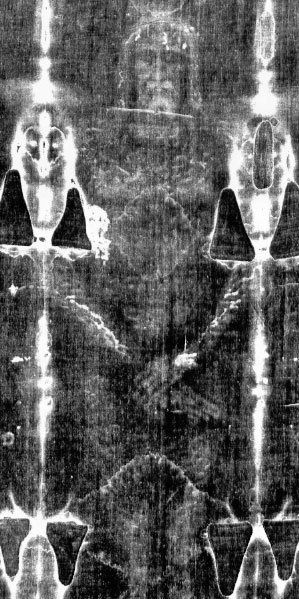
The frontal view of the man on the Shroud of Turin, as seen on the
photographic negative.
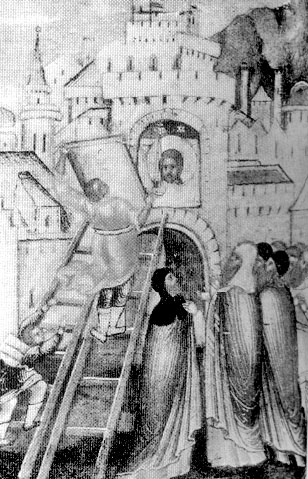
The Shroud is discovered hidden above the gate of Edessa.
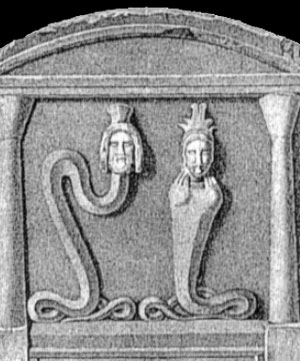
A tile or Stone of Light called the keramion was reputedly
discovered
along with the Shroud of Edessa bearing the same face as
on the cloth.
A member of Napoleon‘s army drew the stone at left in
1798 in Egypt
one hundred years before the first photograph of the
Shroud in 1898.
This face bears an uncanny resemblance to the face
on the Shroud. Is it Jesus?
The Shroud, itself, says Dr. Trenn, is a roll of quasi-undeveloped
film, a photographic negative negative, waiting for the right
moment, the invention of photography, to unmask its hidden true
“positive.”
No one can say for certain what excited X-rays in the bones and
teeth to move outward through the skin into the linen, but Dr. Trenn
thinks that X-ray energy might be the by-product of the primary
dematerialization event --the Crucifixion. In other words, as a
result of the Crucifixion the man in the Shroud was transformed into
a being of light. According to the apocryphal texts, Jesus could
dematerialize and materialize at will. After the Crucifixion he
frequently appeared to his disciples as a being of light.
This hypothesis seems to raise ten provocative questions for every
one it answers.
-
What was the power source for the X-rays?
-
Where did
the man in the Shroud go?
-
What kind of an event, exactly, was the
Crucifixion?
One thing is certain. Finding these answers yields tremendous power,
both spiritually and militarily speaking. In addition to being a
profound key to the Crucifixion, through the centuries the Shroud
(or Grail) has enjoyed a fabled reputation as a palladium possessing
great powers of protection. In 544, it had reportedly saved the city
of Edessa (Thomas’ religious center) from a siege by the mighty
Persian army.
Many warriors throughout history, including Ivan the Terrible and
Adolph Hitler, have sought the military advantage of waving the
Shroud or Grail in an enemy’s face. Like the Ark of Covenant, it was
both a symbol of humankind‘s covenant with God, but also a weapons
system with enormous destructive power. Find the inner secrets of
the Grail, and you find military power beyond your wildest dreams.
Was Osiris’ Pillar of Love, which is strikingly similar in design to
Van De Graaf generator, the X-ray producing device that created the
X-ray on the Shroud of Turin?
If Jesus and Mary Magdalene possessed this nuclear technology, the
question arises: where did they get it?
As noted, the Pillar of Love has for its base a ‘stump’ that
resembles the Ark of the Covenant. A remarkable key to the mystery
we are investigating is contained in the stories of the Ark, the
grapes and a person named Nu, the origins of the word nuclear.
The temples dedicated to the Rainbow Goddess Nu throughout the
Egyptian and Greek world often featured a carved stone or moon boat
containing a figure of a winged or angelic Isis.
At Mari, this goddess was depicted wearing the blue stones that turn
one into a Shining One around her neck. To the ancients the meaning
of this symbol was nu-clear. The winged Rainbow Goddess was bringing
a precious gift to humanity in a boat shaped like an arc. This gift
was the secret of the shining sun god.
In Hebrew history the Babylonian moon goddess Nu-ah and her Arc or
Pandora’s box full of secrets appears in the tale of Noah’s Ark in
which Noah and his family rode-out the Flood.
Genesis 9:8-17 tells how, after the Flood,
Yahweh promised Noah
never again to destroy humankind by water, and as evidence of his
‘covenant’ set a rainbow in the sky. Later, planting the first
vineyard, Noah made wine, got drunk and lay naked in his tent.2
The Ark reappeared at the time of Moses (c. 1,400 BC) as the Ark of
the Covenant, the repository for the Tablets containing the Ten
Commandments. The wine of Noah appeared at the Last Supper.
Another Hebrew story concerning the Ark, the word nun, and the
grapes may provide the answer why. In the relevant episode (Numbers
13) Moses and the Israelites were enroute to the Promised Land.
Yahweh ordered them to stop short and to send out some spies.
One of Moses’ operatives, Joshua, an ancestor of Jesus, was called
the “Son of Nun.” Along with a companion, Joshua was dispatched to
the valley of Eschol (‘valley of the cluster’ as in grapes) where he
stole a cluster of grapes from the sons of Anak who were living
there. He returned the grapes to Moses.
Nun and the cluster of grapes later became cryptograms that were
extremely important to the Essenes, the priesthood of which Jesus
was a member, and the Gnostic Grail heretics that they held sacred
and secret.
The cluster of grapes symbolized the secrets of creation, the
secrets of manipulating the mother substance and the symbol for the
Grail.
These secrets existed before the Flood and were ‘brought over’ into
the new civilization. Significantly, the name Joshua “Son of Nun” in
the Old Testament is the name given in the New Testament as Jesus,
the meaning of the name being “God is my savior.” Nun (N), is the
fourteenth letter of the alphabet. It means ‘fish’, one of the
symbols of Jesus. Webster’s Dictionary says “nun” also refers
to birds.3
From the description of their route given in Numbers and the length
of their excursion (a ‘magical’ or initiatory forty days), it seems
Joshua took a survey of a vast land, one larger than the Holy Land
which can be surveyed in a lot less than forty days.
Joshua and his companion took particular notice of Hebron, the
burial ground of the patriarchs whose bones were thought to “mark”
this territory as human for all time. Hebron (or is it Heron?), to
their horror, was in possession of the sons of Anak (ver. 33) --who
are described not as humans but as
giants!
The giants themselves lived in a place called Eschcol, the ‘valley
of the cluster’ (as in grapes). In a story reminiscent of Jack and
the Beanstalk, we learn that when the spies arrived at the land of
the giants they stole a branch heavy with grapes.
These blue apples are so large it takes two men to carry them (ver.
23,24)! This event is the subject of Poussin's painting.
According to Tatiana Kletzky-Pradere’s alluring account in Rennes-le-Chateau:
A Visitor’s Guide,4 at precisely noon on January 17 the Sun’s rays,
low on the horizon, pass directly through the patterns on
the
stained glass windows of the church of Mary Magdalene and project
onto the opposite wall a tree covered with round fruit resembling
apples.
This stunning effect takes on a remarkable significance as the Sun
moves through the room. As it moves from left to right, the fruits
(changing from blue to red, all except for three of them which
remain blue. This stunning effect is short lived. It becomes blurred
and then disappears completely.
God had promised the Israelites a land flowing with milk and honey.
These grapes were certainly a healthy down payment! One would think
the spies would have returned to Moses enthusiastic about their
future prospects.
Instead, Numbers tells us that upon their return the spies counsel
Moses that attacking this area would be a nightmare.
Why? The cities are impregnable fortresses; they “are walled,” and
“very great” (ver. 28). But that’s not all. Even if they overcame
the walls nothing could prepare them for the sight of the
inhabitants of the vineyards.
“We saw the children of Anak there” (ver.
28), the spies reported, “we saw the giants,” those men of a
prodigious size, the “sons of Anak,” which “come of the giants” (ver.
33).
They speak as if they were ready to tremble at the mention of them.
“Oh these
tremendous giants! When we were near them we were in our
own sight as grasshoppers.”
What kind of carnival freak show could these spies possibly have
seen? The answer is provided once nephilim, the original Hebrew term
used to describe the giants, is decoded. This strange word nephilim
has for ages been mistranslated as ‘giants’, leading to numerous
erroneous interpretations of Old Testament stories including the
story from Numbers 13. One excellent example of its mis-use is
Genesis 6:4 where we learn:
“The Nephilim were on the Earth in those days, and also afterward,
when the Sons of God came in to the daughters of men, and they bore
children to them. These were the mighty men that were of old, the
men of renown.”
Nephilim is not the only word that has been misunderstood in this
passage. As Sumerian scholar
Zecharia Sitchin pointed out in
The
Twelfth Planet,5 the other truly awe-inspiring word that was
mistranslated was one that appears in the last line: renown.
The correct understanding of these two words revolutionizes Earth
history. That other word, shem, has been misinterpreted as renown.
Thus we have inherited the false legacy that the Nephilim were men
of renown when actually the word shem means ‘that which goes up’, as
in rocketships (or light bodies).
Once we remove the obscuring language, we instantly recognize that
what Genesis 6:4, Numbers 13 and the book of Daniel are actually
telling us is that
the Nephilim, the Sons of An-Ak (the Children of
Daniel), the ancient star beings, were on Earth in those days. They,
and their children -- the human-alien hybrids --lived in a valley
near vineyards which produced enormous magical grapes.
The Sumerians called these Nephilim
the A-nun-naki, which as we have
seen, literally translates as ‘those from heaven to Earth came’.
An-un-naki is very close to the ‘sons of An-Ak’ mentioned in
Numbers, and also (not coincidentally) the Ana-sa-zi, the name of
the ancestors of
the Hopi or Opi Indians of the American Southwest
whose name means ‘the peaceful ones’.
According to Sumerian myth, Mari/Inanna received the tablets from
the creator god named E.A or Enki, a key figure in Sumerian
mythology, and in our story.
E.A
was part of an early wave of gods the Sumerians called A-nun-naki,
‘those who came to Earth from Heaven’ in search of gold, rare metals
and radioactive materials, such as uranium or cobalt.6 The latter
were described as the Lower World ’s “blue stones” 7 that could turn a
person into an El or “Shining One.”
E.A
is routinely depicted emerging from between a double mountain
accessed through twin pillars. This God of Wisdom has rays emerging
from his shoulders and streams beneath him.
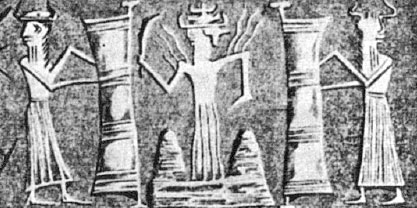
The sun god emerges from between two pillars with a wand or branch
in his hand.
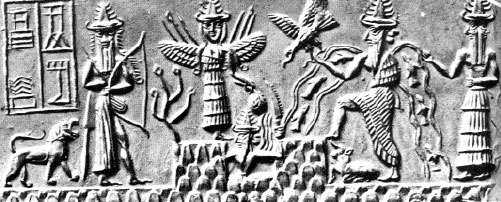
Inanna (with wings) and E.A (with fish swimming around him)
stands
by while the sun god emerges from between two mountains with a
branch or wand in his hand.
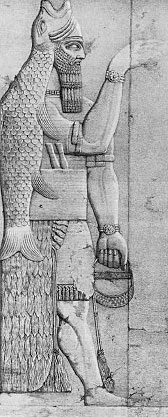
Enki was also called Oannes (“Dove”)
and was depicted as half-man,
half fish.
We should not be surprised to find these
shining Nephilim inhabiting
the holyland. Sumerian records and artifacts decoded by Sitchin
prove that many of the cities in this region were originally founded
by the Nephilim (the A-nun-naki or Elohim) including Jerusalem (the
City of Peace), which according to Sitchin’s scholarship is nothing
less than an A-nun-naki interstellar communications center!
These beings were frequently depicted with wings. They are known as
the Bird Tribe. Their angelic language is called the Language of the
Birds. The alchemists called it the Green Language. It was the
language of nuclear transmutation.
What makes this episode so startling to me is a mind-boggling bit of
intelligence regarding the vineyards of the A-nun-naki discovered by
Moses’ spies.
We know that, as the spies reported, the A-nun-naki were certainly
militarily stronger than the Israelites. The Sumerian recollections
attest they were big in stature and also well armed. This alone
would be good reason to follow God’s advice and not to go trodding
on their territory. But the Israelite spies reported another even
more terrifying (and, therefore to us, a more interesting) reason
for staying out of the vineyards. That is this:
“the land, through which we have gone to search it, is a land that
eateth up the inhabitants thereof”. 8
What a strange and stimulating observation. “The land that eatheth up the inhabitants thereof.” What does this
mean?
Some think that there was a great plague in the country at the time
that they surveyed it. If so, why shroud this simple fact in obscure
language? People in ancient times certainly knew the meaning of the
word plague.
Another interpretation is that the land did not provide enough food
for its people, an interpretation which contradicts the belief that
this was the land of milk and honey.
The phrase, “the land eateth up the people thereof” must have a more
fantastic explanation.
In fact, because of the imprecise language, it must refer to
something the spies did not quite understand. What could it possibly
be that eats people and makes them disappear from the face of the
Earth?
It would be easy to say the spies saw either a space ship (which in
this case they could not imagine, therefore they could not see). If
so, they could have said they saw a “cloud,” a term used dozens of
times in the Bible during episodes that are strikingly similar to
modern day UFO sightings.
If they saw an inner Earth opening that consumed people, they could
easily have said they saw a cave.
So, when they said “the land eateth the people up,” and they saw
either individuals or a group of people disappearing into thin air
leading them to believe the land consumed them, they must have seen
something for which they did not have a word.
We now have such a word: stargate.
My interpretation of the Rennes mystery asks us to imagine the
opening of such a stargate is not some fantasy, but is an actual
event that took place in the vineyards of Rennes-le-Chateau.
It further asks us to imagine this scenario is the most accurate
interpretation of the events foretold to happen in that book to end
all books, the Book of Revelation.
In Revelation 14:19-20 the wrath of God (his cranky Son) appears and
a winepress suddenly opens up:
“And the winepress was trodden without the city, and blood came out
of the winepress, even unto the horse bridles, by the space of a
thousand and six hundred furlongs.”
Now, a furlong is a cubit and a half. A cubit is 18 inches.
After we unzip the calculator and do the math, we learn that the
book of Revelation states the wrath of God will open a 12 and a half
mile winepress somewhere on Earth.
A 12 and a half mile wine press? What the hell is that?
When we unzip this word with our trusty Language of the Birds word
decoder we learn the term winepress means ‘stargate’. A 12 and a
half mile stargate will open within the twenty square mile invisible
temple complex.
What happens once the stargate is open?
“And the angel thrust his sickle into the Earth, and gathered the
vine of the Earth, and cast it into the great winepress of the wrath
of God.”
What or who are the vine? The vine is used in numerous biblical
references to describe the Chosen Ones.
For instance:
“A vine thou
didst bring out of Egypt.” 9
“The vineyard of the Lord of hosts
is the House of Israel and the men of Judah are his cherished
plant.”10
This is likely based on the Sumerian tradition that revered the vine
leaf as the sign for ‘life’. In Babylonian tradition the goddess of
the Tree of Life (the Pillar of Love), who fertilized the ova of Ava
or Eve, was called the ‘Lady of the Vine’.
The ‘Lady of the Vine’ is also known as the Great Mother, whom the
Hebrews called Mer. This is the Egyptian word for love and the root
of the name of Jesus’ mother, Mary, and the Magdalene, his chief
apostle and partner. As noted, it comes through the Latin mare,
meaning ‘sea’. She is sometimes known as the net and her son the
divine fisherman. Jesus was called the ‘fisher of men’.
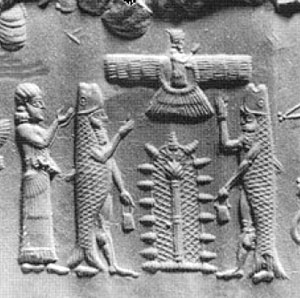
Fish gods tend a pillar, while a god being hovers above.
Interpreting the meaning of this picture means stretching our
imaginations to touch a higher world. The theory of hyperspace
states that dimensions exist beyond the commonly accepted four of
length, width, breadth and space and time. It postulates that our
world actually emerges from a higher dimension. Mystics say this is
where our souls and the flying vehicle depicted above emerged from.
Physicists say it is a source of a limitless supply of free
life-force energy -- love.
A moment ago, I asked that we imagine that a 12 and a half-mile wide stargate suddenly opened up on our beautiful blue apple floating out
in the middle of nowhere in space. Putting a
hyperdimensional accent
on this apple allows us to get to the core of this proposition.
Think of it this way. Scientists used to believe the Earth was flat
like a two-dimensional plane. But then, when we went into space, and
achieved a higher perspective, we altered our perception and could
see that the Earth was round. Many theoretical physicists believe
that knowledge of
higher dimensions will lead to a comprehensive
theory of the universe and will usher in a new golden (or should I
say blue) age for humanity.
This isn’t some New Age kook science. Thousands of the brightest
minds in physics, and massive funding for major research
laboratories around the world, are devoted to uncovering the secrets
of hyperspace. Many of these scientists were inspired by science
fiction stories of time travel, parallel universes, teleportation,
time warps -- all ideas which at one time didn’t make any sense but
are rapidly becoming scientific fact.
Similarly, there are beliefs in mythology that don’t make any sense.
For example, gods in space ships, apples of immortality, enlightened
beings appearing out of thin air. These events will remain a mystery
until we can think hyperdimensionally and unlock ourselves from
a
flat two-dimensional view of our past and our present.
This is why we must understand the concept of the thought-sphere. If
you want to imprison someone in a flat, 2-D world all you have to do
is draw a circle around them. The key to escaping prison is the same
key used to decode the myths of the ancients. It’s not to expand the
circle, that just extends the prison walls. We have to be able to
jump to a hyper level.
Hyperdimensional thinking yields a panoramic overview similar to
that achieved when humanity received the first images of the whole
Earth from space. For the captive on the 2-D world it enables him to
step outside the circle. From this vantage-point the nonsensical can
make sense. In physics, expressing nature in higher dimensions makes
it simpler. This is the central idea behind Einstein’s theory of
relativity. In mythology, expressing stories from a hyper dimension
also makes them simpler too.
In his book
Hyperspace: A Scientific Odyssey Through Parallel
Universes, Time Warps, and the 10th Dimension 11
Michio Kaku tells
the story of a race of tiny flatworms living on the surface of large
apple. The common sense belief in this world, which they call
Appleworld, is that it is flat and two dimensional, like themselves.
One daring worm, Colombus, strips this idea to its core when he gets
the brilliant idea that Appleworld is actually curved in something
he calls the third dimension. Because a third unseen dimension is
theoretically impossible in his two-dimensional world, Colombus is
labeled a fool. So, he journeys into the horizon and eventually
returns home, proving the world is a sphere.
Along the way, the mercurial Colombus discovers another way to
travel between points on the apple: By digging into the apple,
voila, he can create a tunnel that reduces the distance. He calls
these wormholes and with them he proves that the shortest distance
between two points is not a straight line, it is a wormhole. He also
discovers that at the other end of the wormhole time is ticking at a
different rate. He is in the past.
As Colombus’ messianic career progresses in Kaku’s story, he
discovers that Appleworld is just one apple in an immense,
interconnected tree, which itself is in a magnificent
wormhole-riddled orchard or garden. Quite possibly, one can travel
from apple to apple instantaneously, as if there were nothing in
between. (In France, the possibility exists to go from blue apple to
blue apple with nothing in between.)
Can we specifically locate the valley Eschcol, the possible
stargate
location, where Joshua retrieved the Blue Apples in or near Rennes-le-Chateau?
The answer is yes, according to Elizabeth van Buren. She says the
location of the Valley of Eschol in Poussin’s painting is
Rennes-le-Chateau. In the background above the grapes is seen a
mountain peak which is easily recognized as Pech Cardou, a mountain
nearby Rennes.
What might this painting be telling us? In
GENESET authors David
Wood and Ian Campbell offer a unique insight into Pech Cardou, a
view afforded them by looking into Higgins’ Anacalypsis.
In the Language of the Birds, the prefix card refers to all matters
of the heart or the center. Cardiac and cardinal are two examples.
Higgins states that cardo and Ararat (aka Mount Ida) or the Mountain
of Cordi, the name of the mountain upon which Noah's Ark came to
rest, are interchangeable. From Latin, Higgins defines cardo as a
pivot, a hinge, a point about which something turns, and a
place of
crossing.
Shown here is another depiction of the two thieves, Joshua and his
companion. They are carrying the cluster of grapes that they have
brought to the Crucifixion of Jesus. Here, we must ask a critical
question:
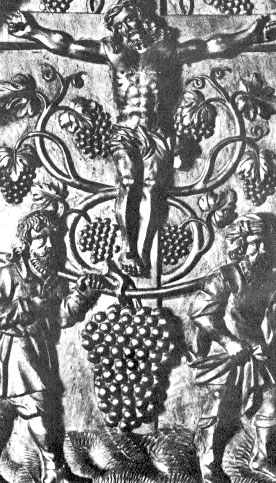
Joshua and Caleb tote the grapes of Eschol to the Crucifixion.
Sion,
Switzerland.
This courageous work of art is simultaneously terror and
awe-inspiring. It comes from the Castle of Valere, in Sion,
Switzerland. Why is it associated with the Crucifixion?
One answer comes from Chartres. There, on the ‘Symbolic Window of
the Redemption’ we see an identical pairing of the two thieves
carrying the cluster of grapes beneath a green Cross. This window
illustrates the medieval belief in the concordance of the two
stories. Old Testament scenes are grouped together with the
Passion
of Jesus as if they happened at the same time.
In the scene of his Passion Jesus is shown carrying another ever
green cross, symbolic of the life-giving power of the blood of
Christ and a reference to the belief that the Cross was made of the
wood of the Tree of Life from the Garden of Eden. Beneath him is the
Old Testament prefiguration, the depiction of Joshua and a companion
stealing a huge bunch of grapes upon a staff.
According to Isidore of Seville, the grapes suspended on a pole
symbolize Christ hanging on the cross, for he is the M-Istic grape
whose blood fills the Grail. In the following scenes on the Passion
window, Jesus is crowned with green thorns, once again inviting us
to conclude that his starry helmet or crown of thorns was made from
the same material (or technology) as the Cross or Pillar, i.e.
palladium.
THE SHROUD IN THE LANGUEDOC
Shroud researcher Jack Markwardk notes that,
“at the precise time
when
the Cathars desperately required protection from Innocent,
their religious brethren in Constantinople were, week after week,
witnessing the exhibition and representation of the alleged burial
cloth of Christ as a tried, true and mighty palladium.”12
In 1203, four years before the attack on the Cathars, the Church’s
search for Christian relics was massively underway. Word of the
Shroud in Byzantine Constantinople influenced the diversion of the
Fourth Crusade to ‘the new Rome’ built by Constantine, to repossess
relics from the schismatic Greeks.
As Ian Wilson observed,13 in April of 1204, the Fourth Crusade
attacked Constantinople and, in the resultant chaos, someone --
other than the pope’s man -- stole the Shroud. The Shroud reappeared
in Lirey, France a century and a half later with no explanation
given for its whereabouts during these “Missing Years.”
Markwardk suggests that it was a Cathar sympathizer who pilfered the
relic, concealed it, and sent it to the Languedoc, not as an object
of religious veneration, but as a powerful palladium that could be
employed against the fanatically-militant Church of Rome. (If my
theory is correct it was used as source material for elucidating the
secret of transmuting the elements.)
Markwardk presents circumstantial evidence from the Grail myth
Parzival in which, he says, its author, Wolfram, clearly
demonstrates that by 1207 it was common knowledge that the Shroud
-was in the possession of the heretics of the Languedoc. Were the
alchemical secrets of how the image upon it was formed there as
well?
Wolfram said the Grail, the palladium, was hidden in a place called
Munsalvaesche, the Mount of Salvation. Templars wearing white
surcoats with red crosses guarded it. This locale’s description was
very much like Montsegur, the Cathar seminary/fortress. On November
12, 1207, Innocent ordered a crusade against the Cathars. Using
trumped-up charges of murder, which the Cathars had nothing do with,
as a pretext for the crusade Innocent launched his military invasion
to retrieve the secrets of the Cathar’s palladium, and then wipe
them off the face of the Earth.
THE CATHAR’S THREE-NAIL CRUCIFIXION
Markwardk observes that in the early thirteenth century, the
Crucifixion was typically depicted with Christ affixed to the cross
with four nails, one placed through each of his hands and feet.
During the Albigensian (Cathar) Crusade, reports were circulated of
a three-nail crucifixion. This gave Innocent all the ammunition he
needed. He proclaimed an official four-nail dogma and condemned as
heretics anyone who asserted the use of three nails.
This three-nail, four-nail Crucifixion business may sound petty.
However, there is a lot riding on the distinction between the two.
“In an attempt to win converts,” says
Markwardk, "some Cathars
employed a crucifix which had no upper arm (a T), the feet of Christ
crossed, and three nails.”
There is a mystery here, he says, of why Cathars, who rejected the
reality of Christ’s death, would assert a three-nail crucifixion or
employ a three-nail crucifix, particularly when attempting to
proselytize orthodox believers who were accustomed to, and who were
bound to believe in, a four-nail “spread-eagle” portrayal.
A close
examination of the Shroud reveals that only one nail pierced
Christ’s feet and the Cathars’ possession of the cloth with its
evidence of the use of one nail through both feet crossed would
explain their assertion of a three-nail crucifixion. Their use of
the Bird Language also links them with Jesus. The Cathars had
clearly drawn a knowledge line in the sand, possibly based upon
actual knowledge from the Shroud, which contradicted the traditional
and papally mandated (mis)beliefs of the conventional Christians in
Rome.
THE LAND OF AK
Markwardk does not offer any additional explanation or further
elucidation regarding the Cathar three-nail Cross mystery.
Speculative though this may be, I have found an explanation for the
meaning of the three-nail cross in the Land of Ak, not in France,
but in the Kingdom of Ak-kad, mentioned in the Bible (Genesis) as
existing in Mesopotamia (mostly now Iraq) before Babylon.
Historians contend that Ak-kad was the first great empire in
history. Sargon who, after an affair with the goddess Inanna, became
the ‘Righteous Ruler’ founded it. He built his empire in Mesopotamia
during the 2300’s BC and gained control over much of southwestern
Asia.14
Beginning in the early 1900’s teams of archaeologists discovered the
remains of Akkad. They began stocking the world’s museums with the
remains of Akkad: ceremonial gates, bas-reliefs of winged-bulls,
chariots, gold jewelry. The most valuable of their artifacts, as far
as we are concerned, was their writings. Thousands upon thousands of
records written in cuneiform (from “cuneus,” Latin for wedge) script
were recovered. Cuneiform is a triangular, pyramid-shaped language.
“Like bird tracks on wet sand.” This is how cuneiform script struck
the first Europeans to lay eyes on it. Once deciphered
archaeologists learned these records contained cosmological myths,
epic poems, histories of kings, astronomical tables, mathematical
formulas, grammar and vocabulary school texts. Most prized of all
were their recollections of the comings, goings and doings of the
gods.
Here is the connection to the Cathar three-nail cross. Whenever
archaeologists discovered remains of the early Sumerian
civilizations, including Akkad, the symbol of the “Planet of the
Gods” was prominently displayed. The name for their home was
Nibiru
or NAM.TILLA.KU, “the god who maintains life.” Nam.Tilla.Ku
literally means Name or Destiny (NAM) of God (KU) is
Tula (TILLA).
Tula was known to the Akkadians as the:
“bestower of cultivation,”
creator or grain and herbs who causes vegetation to sprout,”
who opened wells, apportioning waters of abundance,” and
irrigator of Heaven and Earth.”
15
The Akkadian astronomical and religious beliefs maintained
Nam.Tilla.Ku was a twelfth planet in our solar system. They
sometimes called it the Lord.
The pictographic sign for this planet was a three-nail
16
cross.
The cuneiform cross sign was composed of three wedge-like symbols
that resemble nails. This three-nail cross sign, says Sumerian
scholar Zecharia Sitchin, meant “Anu” and “divine.” It evolved, he
says, in the Semitic languages to the letter T or tau.
Anu was
another name for the ultimate a-tom of the Theosophists. If the
a-tom is the sun, Tula, the Anu, is the sun behind the sun.
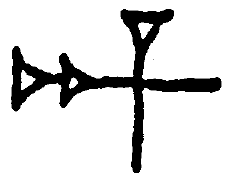
The three-nail cuneiform Akkadian cross, symbol for ‘god.’
Nam.Tilla.Ku was the home of E.A the fish god.
What, I must ask, are the odds that the Cathars, who spoke the
language of Ak, would revere a three-nail cross that precisely
matches description of the divine three-nail cross of Akkad
twenty-three centuries before them?
The Cathars are thought to have possessed the Grail: the secret of
peace, the secret of transforming the wasteland into a garden, and a
powerful palladium.
In an identical tradition, recorded in Mesopotamian texts, when the
“Planet of the Gods” appeared it would usher in a new era. “Peace
would descend on land… Akkad would overflow with plenty and the king
of Akkad would grow powerful,” say the texts. Like the Grail, the
appearance of Nam.Tilla.Ku gave the King virility.
The similarities between the Mesopotamian prophecy of the return of
the Planet of the Gods (Tula) and the transformation of humanity and
Earth with the return of the Grail are an extraordinary coincidence.
The Hebrew prophet Isaiah’s prophecy of peace that would wash over
the Earth after the Day of the Lord bears more than a passing
resemblance to this theme:
“And it shall come to pass at the End of
Days… the Lord shall judge among the nations and shall rebuke many
peoples. They shall beat their swords into ploughshares and their
spears into pruning hooks; nation shall not lift up sword against
nation.”
For some strange reason, the pope was seeking to eradicate the
three-nail cross symbol of Peace that brought balance to humanity.
One other point is meaningful here. The gods from Tula were called
A-nun-naki. Sitchin interprets this name as “those who came to Earth
from Heaven.”17 In the
Language of the Birds, the A-nun-naki may be
interpreted as the holy (an) fish (nun), of Light (aki).
The “sons of Anak” were the ones from whom Joshua son of Nun stole
the cluster of grapes. The fish-suited gardener who came from this
land brought his remarkably creative Pillar with him. The sign of
the Fish-god who tended the I-link and the Net between Heaven and
Earth was an H.
To me the surprising correspondences between the Cathar three-nail
cross and the Anunnaki three-wedge cross suggest that the Cathars
were reviving an ancient religion based upon the worship of a group
of gods, including E.A, who came from a ‘missing’ planet in our
solar system.
Back to
Contents
|








